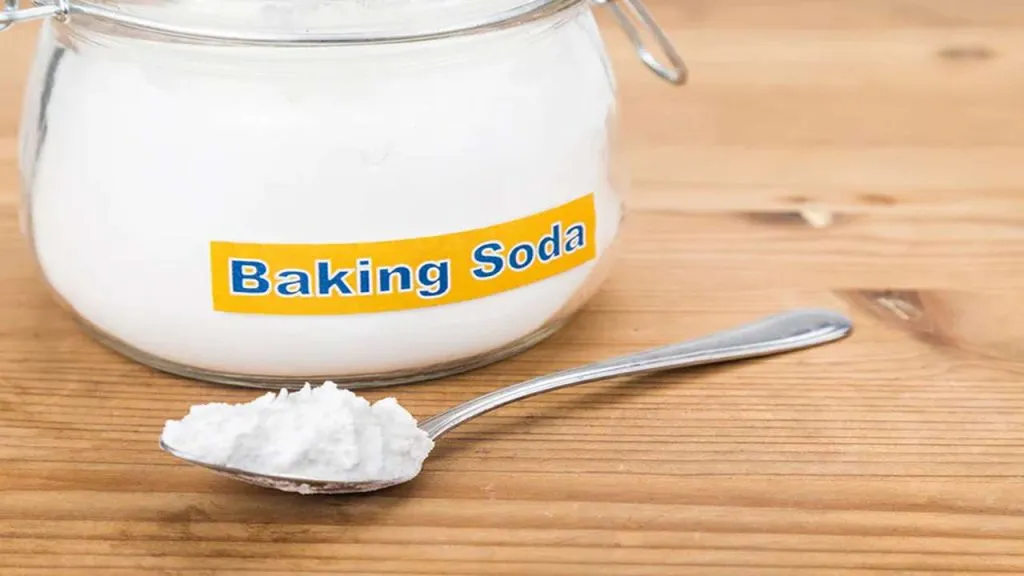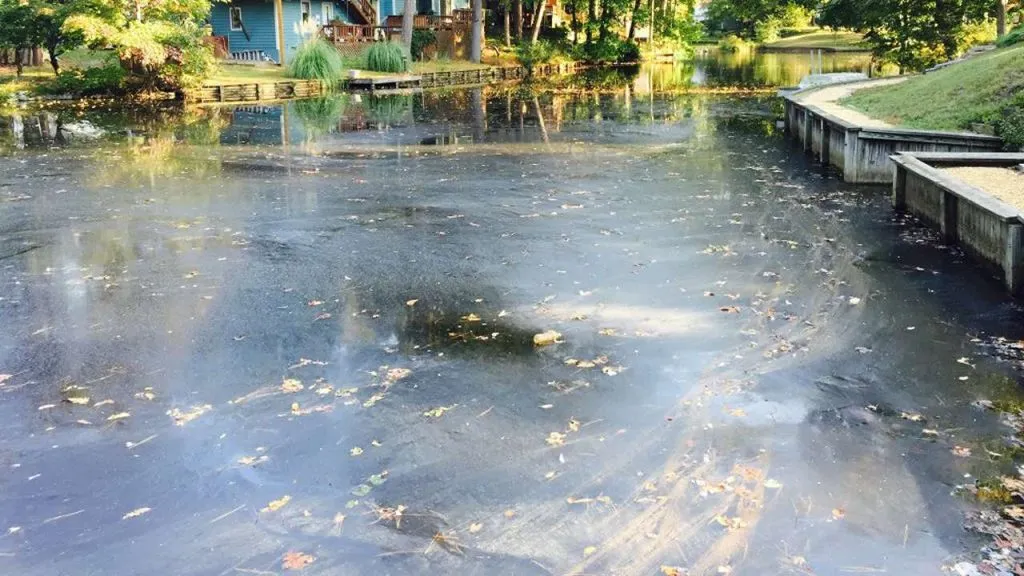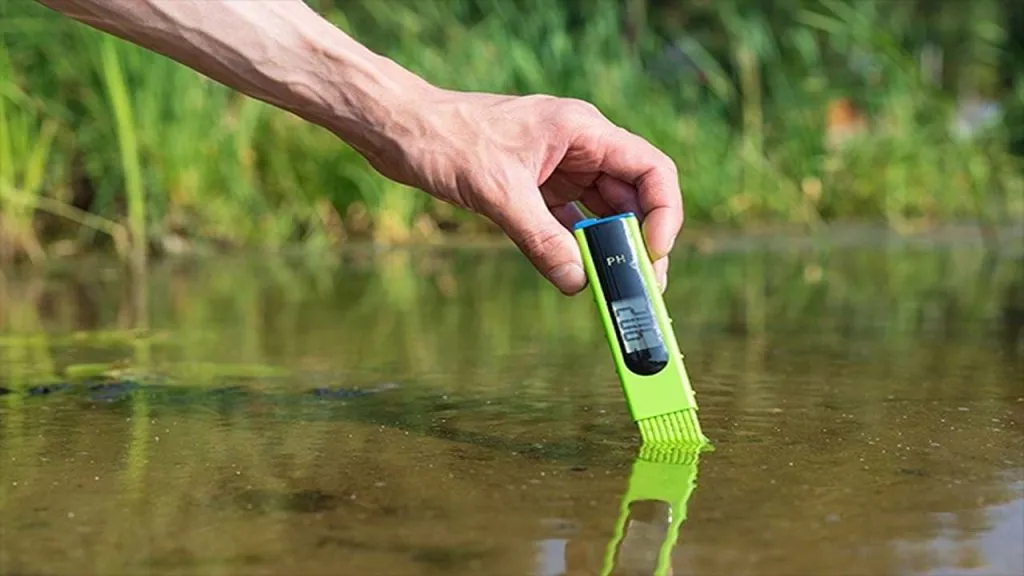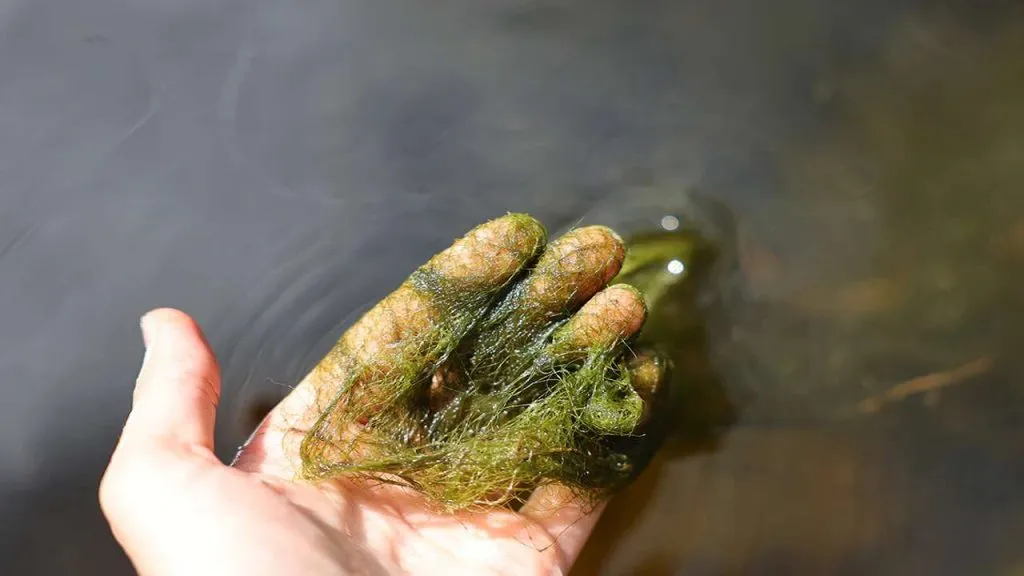As an Amazon Associate I earn from qualifying purchases.
Struggling with algae in your pond? Baking soda may be the natural, easy fix you need.
It helps balance pH and alkalinity levels, which in turn reduces algae growth. Plus, unlike harsh chemicals, it’s safe for fish health and plants when used properly.
In this guide, you’ll learn how baking soda works in a pond ecosystem, when it helps, and when it doesn’t.
We’ll also cover application tips and how to combine it effectively with other algae control methods.

Understanding Healthy Pond Ecosystems
Every pond, whether it’s a small backyard setup or a large water feature, has its own little and clean aquatic ecosystem.
It must remain balanced to stay healthy, and that balance begins with water chemistry.
A. The Crucial Role of pH and Alkalinity in Ponds
The pH level in your pond indicates the acidity or alkalinity of the water. Most ponds do best with a pH between 7.0 and 8.5.
If it drops too low, it can stress fish and slow down the growth of aquatic plants.
Alkalinity is what keeps that pH from swinging too fast. It acts like a buffer, holding things steady.
When alkalinity level is too low, the pond becomes more vulnerable to carbon dioxide spikes, acid rain, or runoff, all of which can trigger algae problems.
Adding baking soda (sodium bicarbonate) can raise carbonate hardness (KH), which supports stable pH and helps keep the ecosystem from tipping out of balance.
B. How Algae Affects Pond Health
Algae start small, then spread fast in warmer weather or ponds with too much organic matter (like leaves, fish waste, or uneaten food).
Some algae are normal, but when they bloom, they can:
- Block sunlight from reaching beneficial plants like water lilies
- Lower oxygen levels, especially at night
- Make the water look cloudy or green
- Stress fish or cause gill irritation
Heavy algae growth can also mess with the pond’s natural cycles, making it harder for good bacteria to break down waste properly.
C. Importance of Water Quality Parameters
Keeping water clean isn’t just about visibility; it’s about chemical balance. When you keep an eye on the right numbers, everything else tends to follow.
Here’s what to monitor regularly:
- pH levels (ideal: 7.0 to 8.5)
- Alkalinity (KH) for pH stability
- Ammonia and nitrite (both should be near zero)
- Carbon dioxide levels
- Phosphate and nitrate, which feed algae if they’re too high
Using a water testing kit at least once a week, or after heavy rain or treatments, is the best way to catch problems early and keep a stable environment for different types of plants and fish.
Next, we’ll look at how baking soda fits into this picture and why it can help reduce algae without harming your pond’s balance.
Effects of Baking Soda on Algae

Adding baking soda to a pond won’t kill algae on contact, but it can help prevent future blooms by improving your water’s stability.
A. How Baking Soda Impacts pH Levels
Baking soda is a mild alkaline substance. When added to pond water, it raises the alkalinity and gently shifts the pH levels toward the neutral-to-alkaline water range, usually around 8.3.
This helps in two big ways:
- Keeps pH stable, which prevents sudden shifts that stress pond fish
- Creates a less favorable environment for green algae and blue-green algae, which tend to thrive in fluctuating or acidic water conditions
Algae species doesn’t like consistency. Keeping your water chemistry balanced makes it harder for it to spread.
B. The Science Behind Baking Soda’s Effectiveness
At the chemical level, baking soda boosts carbonate hardness (KH). This acts like a buffer against acids, including carbonic acid, which forms when CO₂ dissolves in water.
When KH is too low:
- CO₂ builds up faster, lowering pH
- Algae may use that carbon dioxide as fuel
- The pond becomes more unstable overall
Raising alkalinity of water with baking soda reduces these swings, keeping carbon dioxide levels in check. This indirectly slows algae growth by limiting one of its resources.
Baking soda creates a more stable environment, making it easier for plants, pond fish, and bacteria to do their jobs and making it harder for algae to take over.
Next, we’ll look at why baking soda is a popular choice for pond owners, especially those who want a quick solution that’s gentle, affordable, and compatible with other natural methods.
Benefits of Using Baking Soda
Baking soda may seem like a basic solution, but it checks several boxes for pond owners seeking a simple and reliable way to enhance water conditions.
A. Natural and Safe for Aquatic Animals and Plants
One of the biggest advantages is that baking soda is gentle. Unlike strong algaecides or harsh chemicals, it doesn’t harm:
- Pond fish (when used correctly and in the right dosage)
- Water lilies and other aquatic plants
- The beneficial bacteria that help maintain a balanced ecosystem
It doesn’t kill algae directly, but by improving pH stability, it supports a healthier environment for all other organisms in your pond.
B. Cost-effectiveness and Accessibility
You don’t need any specialty products or complicated treatments here. Baking soda is:
- Affordable and widely available
- Easy to measure and apply
- A good option for both small backyard ponds and larger setups
For many pond owners, it’s a practical first step before reaching for more expensive or chemical-heavy products.
C. Complementary to Other Methods
Baking soda works best when it’s part of a bigger plan. On its own, it won’t clear up a severe algae bloom, but it helps create the right conditions for:
- Beneficial bacteria thrive
- Aquatic plant growth to outcompete algae
- Better performance from natural methods like aeration or nutrient control
Think of it as a support tool, not a cure-all, but something that helps other treatments work more effectively.
Next, we’ll cover how to actually use baking soda in a pond, including how much to add, how often to use it, and what to watch for along the way.
Application of Baking Soda in Ponds

Baking soda is easy to use, but it’s still important to dose it correctly. Too little won’t have much effect. Too much can swing your pH levels too far, and stress your fish or plants.
A. Proper Dosage and Application Techniques
The general rule of thumb is to add 1 tablespoon of baking soda per 100 gallons of pond water to raise alkalinity gently. But before adding anything, always test your current pH and KH (carbonate hardness) using a water testing kit.
Here’s a basic dosage guide:
| Pond Size (Gallons) | Starting Dose of Baking Soda | Notes |
| 500 gallons | 5 tablespoons | Add slowly across surface |
| 1,000 gallons | 10 tablespoons (approx. ⅔ cup) | Mix in a bucket first if possible |
| 2,000 gallons | 1 ⅓ cups | Spread in multiple locations |
| 5,000 gallons | 3⅓ cups | Test KH before repeating |
Tips for safe application:
- Dissolve baking soda in a separate bucket of pond water before adding
- Apply when the sun is low, early morning or evening works best
- Run your pump or aerator during and after to help it spread evenly
- Wait 24 hours before retesting the water
B. Frequency of Use
How often you use baking soda depends on your pond’s conditions. For most ponds with steady carbonate hardness, a single dose may be enough to stabilize pH for several weeks.
Use it:
- After heavy rain that may lower pH
- When your KH drops below 80 ppm
- If you’re noticing algae growth alongside pH swings
- As part of routine monthly maintenance in low-buffer ponds
Avoid using it daily or in large amounts without testing first. It’s not meant to be a quick fix for algae, just a gentle tool to support a stable and clean environment.
Next, we’ll explore how baking soda fits alongside other algae control strategies, from water aeration to nutrient management.
Integrating Baking Soda with Other Algae Control Methods
Baking soda helps create a more stable pond environment, but it works best when paired with other algae-fighting methods.
A. Encouraging Beneficial Bacteria
Beneficial bacteria play a key role in breaking down organic matter like fish waste, decaying leaves, and uneaten food, all of which feed algae if left unchecked.
To support healthy bacteria:
- Add a bacterial supplement after water changes or algae treatments
- Avoid overusing harsh chemicals that kill off bacteria
- Maintain stable pH and KH levels with baking soda
- Keep your filters clean, but don’t rinse them with tap water (it kills good bacteria)
The more good bacteria in your system, the harder it is for algae to take hold.
B. Utilizing Water Aeration
Aeration keeps things moving and improves oxygen levels, which helps plants, fish, and bacteria thrive.
Benefits of adding aeration:
- Disrupts algae’s ability to settle and grow
- Boosts biological activity in filters and the pond itself
- Helps maintain cooler water temperatures in summer
- Reduces carbon dioxide buildup, especially overnight
If your pond has a waterfall, fountain, or air pump, you’re already ahead; just make sure it’s running consistently during warm months.
C. Nutrient Control and Management
Algae feed on excess nitrates and phosphates. The more nutrients in your pond, the more algae you’ll see, no matter how good your pH looks.
To reduce nutrient buildup:
- Avoid overfeeding fish
- Remove dead leaves and debris before they sink
- Rinse water conditioners and additives before use
- Do partial water changes regularly (use dechlorinated water)
- Add floating plants or marginal plants to absorb excess nutrients
When nutrient levels drop, algae have less to survive on. That’s when your natural methods, including baking soda, work best.
Next, we’ll look at simple prevention tips you can use to keep algae under control year-round, starting with plant growth and water testing.
Preventative Measures for Algae Control

Once you’ve treated algae and stabilized your pond with tools like baking soda, the next step is keeping it that way.
Prevention is easier (and cheaper) than dealing with another bloom down the line.
A. Managing Plant Growth
Aquatic plants play a big role in algae prevention. They absorb excess nutrients, shade the water, and compete directly with algae for resources.
Here’s how to make the most of them:
- Add a mix of floating plants (like water lettuce), marginals, and deep-water plants like water lilies
- Cover about 60–70% of the pond surface with plants in warmer months
- Trim dead leaves and remove decaying matter to reduce organic materials in the water
- Rotate fast-growing plants seasonally to avoid overcrowding
Healthy, well-managed plants create a natural line of defense against algae.
B. Maintaining Oxygen Levels
Oxygen is key to a balanced ecosystem. It supports fish, beneficial bacteria, and helps prevent algae from taking over.
Tips to keep oxygen levels steady:
- Run aerators or fountains consistently, especially overnight and during summer
- Avoid overstocking fish, which increases oxygen demand
- Add oxygenating plants like hornwort or anacharis
- Clear out sludge or muck at the bottom that can deplete oxygen as it decays
Oxygen dips are often followed by algae surges. Keeping it stable is one of the best long-term defenses you have.
C. Monitoring Water Quality Regularly
Testing your water isn’t just for when something looks off; it’s a core part of pond maintenance.
Here’s a quick cheat sheet:
| Parameter | Ideal Range | Why It Matters |
| pH | 7.0 to 8.5 | Stability prevents algae-friendly swings |
| KH (Alkalinity) | 100–150 ppm | Supports stable pH and CO₂ buffering |
| Ammonia/Nitrite | 0 ppm | High levels stress fish and feed algae |
| Nitrate | < 40 ppm (lower is better) | Excess fuels algae growth |
| Phosphate | < 0.1 ppm | A major algae food source |
| Oxygen (DO) | 5–7 ppm | Supports fish and bacteria |
Using a simple water testing kit once a week (or after rain, algae blooms, or treatments) can help you keep your pond in check all season long.
Conclusion
Baking soda isn’t a miracle fix, but it’s a reliable, affordable tool that can help stabilize your pond and keep algae under control.
By gently raising alkalinity and supporting a more balanced environment, it makes life easier for fish, plants, and beneficial bacteria, and tougher for algae to take over.
When combined with good habits like water testing, aeration, and proper plant care, it becomes part of a simple, natural approach to a healthier pond ecosystem.
Stick with steady maintenance, monitor your water regularly, and use baking soda wisely, and you’ll be well on your way to clear, clean, algae-free water.
FAQ’s:
Not directly. Baking soda doesn’t kill algae like an algaecide does, but it helps control growth by improving pH stability and alkalinity, which makes conditions less favorable for algae to thrive.
A general starting point is 1 tablespoon per 100 gallons of water. Always test your water first and adjust slowly to avoid sudden pH shifts. Overdosing can harm fish or sensitive plants.
Yes, when used correctly. Baking soda is one of the safer options for adjusting alkalinity in ponds with fish or delicate plants. It won’t burn gills or damage root systems the way harsher chemicals might.
Absolutely. It works best when paired with beneficial bacteria, aeration, and proper nutrient management. Baking soda isn’t a replacement for full treatments — it’s a support tool for a more stable environment.
5. What are the ideal water parameters for algae prevention?
Here’s a quick reference guide:
| Water Parameter | Ideal Range | Why It Matters |
| pH | 7.0–8.5 | Keeps fish healthy, discourages algae |
| KH (Alkalinity) | 100–150 ppm | Buffers pH swings, supports CO₂ balance |
| Nitrate | Below 40 ppm | High levels feed algae |
| Phosphate | Below 0.1 ppm | Prevents excessive algae growth |
Keeping these levels steady is the best way to stop algae before it starts.
Amazon and the Amazon logo are trademarks of Amazon.com, Inc, or its affiliates
